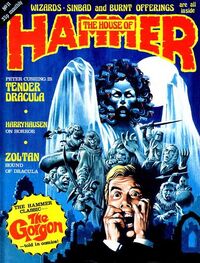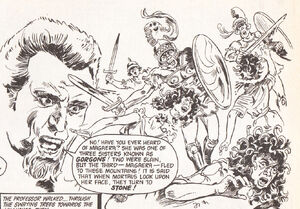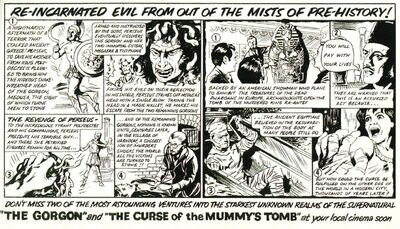
The House of Hammer issue 11, with "The Gorgon" as cover feature.
"The Gorgon" is a comic strip which appeared in issues 11 and 12 of The House of Hammer. It was adapted from the 1964 Hammer film of the same name by writer Scott Goodall and artists Trevor Goring and Manuel Cuyás.
Synopsis[]
Part 1[]
The story is set in the Carpathian village of Vandorf in 1910. In the nearby Castle Borski, a monster is said to live...
Meanwhile, beneath a full moon, the artist Bruno Heitz is engaged in a quarrel with his lover Sascha. Bruno dashes out of the house and Sascha follows, but before she can catch up with him she is killed by the snake-haired Gorgon. Her body is brought to a local doctor, Namaroff, whose assistant Carla Hoffman is aghast to find that the victim has turned to stone - as had six other victims of unsolved murders in the past five years.
The police find Bruno's body hanging from a tree, and the court blames him for the girl's murder, with Doctor Namaroff falsely claiming that he had found wounds in the body's head. Bruno's father, Jules Heitz, is outraged to see his dead son being used as a scapegoat and determines to track down the real killer.
Heitz tracks down Namraoff and accuses him of partaking in a cover-up; he suggests that the true culprit is none other than the Gorgon Megaera, who - according to legend - was the only one who survived, and fled to the Carpathian mountains. Namaroff dismisses this as superstitious rubbish.

Sascha meets Megaera
On his way back Professor Heitz is attacked by a lynch-mob of irate villagers, but with the aid of his servent he reaches his home safely. "The people of Vandorf hate me because they are terrified of what I might find out", he comments. Heitz proceeds to write a telegram to his other son Paul, who is studying at Leipzig University. That night, while conducting his research, the professor feels a supernatural wind which draws him against his will to Castle Borski. There, he ends up face to face with Megaera.
Realising that his life will soon be over, the professor runs back home and writes a letter for his son Paul, his hands gradually turning to stone in the process.
Part 2[]
Paul Heitz arrives in Vandorf following his father's death. He learns that Namaroff has decreed that the professor died of a heart failure - but will not let Paul see the body. Finding his father's letter, Paul concludes that Namoroff is lying; he expresses his concerns to Carla, who shows sympathy and tells him that the spirit of Megaera is said to haunt Castle Borski.
Carla then speaks to Namaroff, who declares that Megaera's spirit has taken on human form. When she hears that a mad woman named Martha has escaped from the hospital, she begins to suspect that Martha is the Gorgon.
Later on Paul has an encounter with Megaera, but survives as he only sees her face reflected in water. Meanwhile, Martha is found dead, having committed suicide; Carla tells Namaroff about her suspicions, but he denies that Martha was Megaera's incarnation.
Paul digs up the body of his father, and finds that it had turned to stone. He is visited by the grave by Carla; Paul reveals that he loves her, and asks if she could elope with him from Vandorf. She says that she must stay until the trouble is seen through.
Paul is then given a surprise visit from Professor Meister, his teacher at Leipzig University who has come for news about the late Professor Heinz. Meister believes Paul's tale about the Gorgon and conducts some research into local women, finding that Carla suffered from amnesia five years beforehand - the time when the Gorgon's killings began. To Paul's horror, Meister concludes that Carla is possessed by the spirit of Megaera, and turns into a Gorgon every full moon.
Nonetheless, Paul still plans to elope with her, much to the consternation of both Namaroff and Meister. Paul dashes off to meet her at Castle Borski, but finds Namaroff waiting for him. The two fight until Megaera suddenly arrives and turns Namaroff to stone.
Meister arrives on the scene and decapitated Megaera with a sword, but he is too late: Paul has already caught a fatal look at the Gorgon's face. As Paul turns to stone Megaera's severed head changes back into that of Carla. "She's free now, Paul..." says Meister. "...You're both free in a better world beyond the grave!"
Background[]

Professor Heitz relates the Hammer version of the myth.
The comic is a reasonably faithful adaptation of the film, with one notable alteration being that the fictional village of Vandorf is relocated from Germany to the Carpathian Mountains; as Count Dracula lived in the Carpathians, this was presumably in the name of tradition. Oddly, Paul and Meister's university remains in Leipzig, making their journeys to Vandorf considerably longer.
Like the film, the comic is an exercise in taking the well-known mythological figure of the Gorgon and placing her into the gothic milieu of the Dracula and Frankenstein films that Hammer was known for. In doing so, it plays pretty loose with the Greek myths.
The Gorgons are here named Medusa, Tisiphone and Megaera; this is a conflation of the mythical Gorgons (Medusa, Stheno and Eurynale) with another trio of snake-haired women, the Erinyes or Furies (Alecto, Tisiphone and Megaera). Hammer's version of the legend states that two of the Gorgons were killed (the comic goes a step further than the film in this regard, showing a single-panel flashback in which Perseus is accompanied by two other warriors, one of whom is killing Tisiphone), but traditionally Medusa's two sisters were both immortal. The story of a Gorgon fleeing to Vandorf is, of course, invented for the Hammer version, while the idea of an ordinary person unwillingly becoming a Gorgon beneath the full moon is an interpolation from the werewolf legend - although it does have a tenuous mythological basis, as Medusa was a once beautiful woman who became a Gorgon after being cursed.
Promotional comic[]

The House of Hammer adaptation was not the first comic to tie in with The Gorgon. The film was released as part of a double bill with The Curse of the Mummy's Tomb; the press book for the latter film included a pair of four-panel comic strips, one for each film, which were intended to be published in newspapers.[1]
References[]
- ↑ The Hammer Vault by Marcus Hearn, p.73.